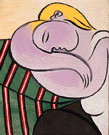|
Taken
together, the collections of the Guggenheim and the Musé national d'art moderne
reveal the close relationship between the Analytical
Cubist styles of Pablo Picasso and Georges Braque. In the
summer of 1911, the two artists worked side by side in
Cé, France--so closely, in fact, that it is
difficult to distinguish one artist's work from the
other. Both Picasso's The
Accordionist (summer 1911) and Braque's Still Life with Violin (1911)
abandon Renaissance perspective, breaking the surfaces of
objects into a multitude of planes to show many sides
within the same view. The subsequent development of
Synthetic Cubism, characterized by the addition of color,
patterned surfaces, stenciling, and collage, can be seen
in Picasso's Portrait of a Young
Girl (1914) and Braque's Woman with Guitar (1913), as well as the
work of Juan Gris.
By the
mid-1920s, the paths of Picasso and Braque had diverged.
Braque's The Bowl of Grapes
(1926) is essentially a continuation of his prewar
practice of Synthetic Cubism, while Picasso's Still Life with Classical Bust
(1925), with its biomorphic forms, marks his turn to
Surrealism.
Picasso
engaged in significant exchanges with other artists as
well. Julio González taught Picasso how to weld
iron, and both artists created sculptures that related to
Picasso's paintings of the late 1920s. A dialogue between
Picasso and Henri Matisse later in their careers resulted
in such works as Picasso's Woman
with Yellow Hair (December 1931) and Matisse's The
Dream (1935), both of which treat the subject of sleeping
beauties.
|

